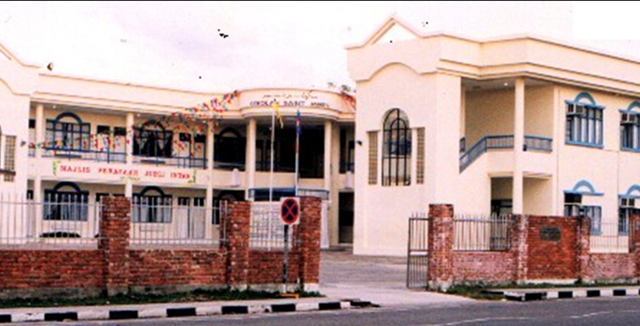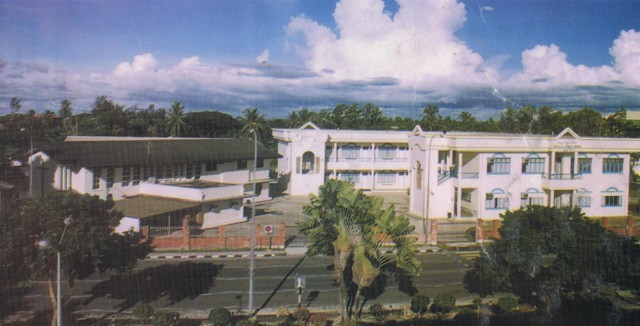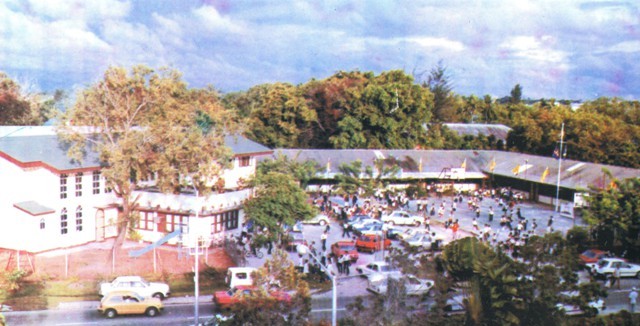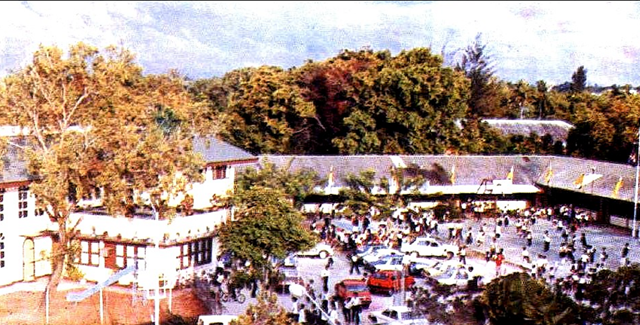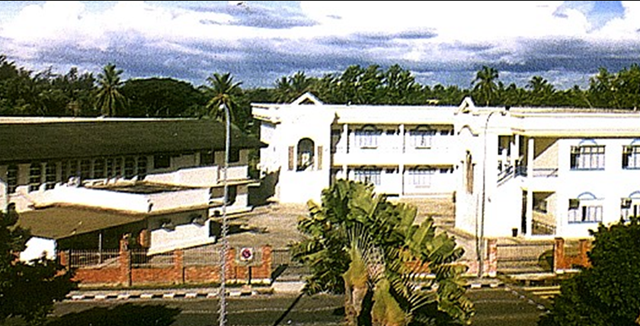Pre - World War II Period : 1930 – 1946
The discovery of oil in Brunei in 1920 brought about migration of expatriates who pioneered in the fertile oilfields of the British Protectorate. As work opportunities became more abundant, this community of expatriates who professed different creeds also thrived. A church were Anglican Church in 1930. The oil discovery, the influx of expatriate workers and the Anglican Church missionary work would collectively contribute a very significant role to the birth of St. James’s School.
In 1931, The Anglican Church with the help and cooperation of the Brunei State Government, and the British Malayan Petroleum Company started the Kuala Belait English School, the first English Medium school in the State of Brunei.
The school was managed by a Board of Governors of six members: Three representatives from the BMP Co. and one representative each from the Brunei State Government, the Anglican Church and the Chinese community. Its first appointed Headmaster was Mr. Chin Chi Chung.
The school started with twenty children in 1939, and by 1940, the number had increased to seventy pupils. Further progress was impossible when the Japanese Imperial Army occupied Kuala Belait on 16 December 1941. All schools activities ceased for the duration of the war. However, worst things were to come. The relief of Borneo began in May 1945. The Australian 8th Army began this in earnest with the bombing of Kuala Belait. The Church building received a direct hit, and due to staffing difficulties. No further effort was made to establish a school in Kuala Belait or Seria during the next eight years. From 1947 to 1954, time stood still.
Significant Dates::
Post World War II Period : 1955 to 1969
The establishment of Anglican Schools in the Belait District could be attributed to the efforts of Rev. Leonard Richard Melling, the first resident Vicar who formed exploratory committees to find ways and means to start Anglican Schools shortly after his arrival to Brunei in 1955. With modest financial support from private companies and generous Anglican parishioners, St. James’s School and St. Margaret’s School were established by the Board of Governors of Anglican Church Schools, Seria and Kuala Belait the following year and subsequently inaugurated on Sunday, 8th April 1956. Both schools which followed identical timetables, textbooks and Teacher’s Scheme of Work came under the supervision of the first Principal, Rev. L.R. Melling who held office in Seria.
The first St. James’s School classrooms were initially housed in the old wooden church built from the rubbles of an earlier Anglican Church built in in the 1930’s but destroyed during World War II. With an enrollment of 18 young and eager Chinese-Malay pupils, Mrs. Yap Shak Chung (Peggy) St. James’s pioneer teacher, taught her first lessons on Monday, 9th April 1956. Within six months, the number of pupils had increased from 18 to 40. Primary 1 and 2 classes were started and the services of another teacher, Mrs. Lai En Phin were engaged. In September 1957, Miss Olwen Parker took charge of the school.
St. james’s School served those families in Kuala Belait who wished to send their children to St. Margaret’s School but who felt that the long bus journey to Seria was too strenuous for the small children. Accordingly, the children studied at St. James’s until they completed Primary 2 and then moved into an appropriate Primary 3 class at St. Margaret’s. Parents paid very minimal fees for their children’s education in those days, $9- per month for Primary 1 and $10- for Primary 2. In addition, a general levy of $1 – was also being charged to raise funds for the school’s expansion. Free schooling or reduction in school fees were at the discretion of the Principal.
The need to expand and build a new church and school building had to be met due to the growing number of parishioners and students. Through a government grant-in-aid and a $40,000 loan together with financial contributions from B.M.P Co., business houses, parishioners and well-wishers, the corner stone of the new church cum school was laid on 9th August 1957 and the structure completed by December that same year.
St. James’s School continued to flourish through the 60’s. Mr. John Heath was appointed as the new Headmaster of both schools at the beginning of the year and later promoted as Principal in 1963 with Mr. P>E Mathews as Headmaster. Primary 3, 4, 5, and 6 were later added and classes were conducted in both morning and afternoon to meet the shortage of classrooms.
An L-shaped school building was later completed in 1966 which made it possible to conduct all classes in the morning. 1966 was an important year for St. James’s as it marked the start of the Lower Secondary education when a Form 1 class was started. Form 2 was started in 1967 and Form 3 in 1968.
At the end of 1968, the first batch of St. James’s students sat for the L.C.E Examination for the first time. By the end of that same year, the student population had grown to 249 pupils in the Primary Department and 88 students in the Secondary.
The Seventies
The memories of the 70’s could be best transcribed for personal recollections of former St. James’s students who are now members of the school’s teaching staff. They vividly recall that conditions during those days were very much different from today. There were so much greenery around then, trees and vegetation surrounded the school’s perimeter fenced with wire and the main school grounds was not yet concreted. Most students either cycled or walked to school, only children from affluent families enjoyed the benefits of transport. One teacher fondly reminisces that her daily allowance was a meager 20 cents, just enough to buy her a packet of ‘mee’ and a drink at breaktime.
The student population was predominantly Chinese although there were also expatriate students from Malaysia and India, and a number of Malay students. Before the present blue and white uniform was introduced years ago, girls wore white blouses and checkered gray skirts while the boys wore white shorts and khaki pants. School hours were longer then, from 7:3o a.m. to 1 p.m., Monday to Friday and often, students had to come back to school in the afternoon to attend either Malay or Home Science lessons. Teachers were much stricter and occasionally, caned erring students.
During Mr. E.R. Bloomfield’s tenure as Principal during the mid-70’s, students were highly involved in extracurricular activities. A school clean-up campaign was conducted every week Jumble Sale and Funfares were organized regularly to raised funds for the school. Mr. Bloomfield taught the students hymns in a weekly singing session in church while his wife taught students Maori dancing and how to play the recorder.
The Eighties
On 1st January 1980, a new school Board of Governors made up of professionals from Brunei Shell, the government and business sector took over with Mr. Arthur Yapp as Chairman. Rev. Peter Ng superseded Mr. Abraham Thomas as Principal that year and assumed the post until 1981. That same year, the first batch of Form 4 students was taken in.
The student population of St. James’s was at its peak in 1982. There were 404 in the Secondary and 771 in the Primary for a total of 1,175 students. This also marked the year Fr. Phillip Than took over as Principal. Academically, the school was advancing and improving. In 1983, P.C.E. results reached the 80% level. A milestone was achieved when the first group of Form 5 students sat for the G.C.E. ‘O’ Level Examination.
Major renovation and improvement of the school’s premises took place in 1984. The staff room was extended ad renovated to its present size. Tuck shop and toilet facilities were improved, the main entrance area concreted and a main gate was put up for the children’s security and safety.
The Sepak Tekraw court was painted and the Kindergarten playground received a new grass turfing. Concerned with the welfare of its students, the board of Governors introduced the Student Insurance Scheme whereby for $20., students were insured in the event of death or disability.
The untimely death of the President of the Board of Governors, Rev. Datuk Basil Temenggong on 22 September 1984 ushered a new president, Rt. Rev John Leong Chee Yun, Bishop of Borneo.
The school re-activated the Monitor-Prefect system to help teachers maintain discipline at school. Creativity and teamwork won St. James Its first Inter-school Archway Competition. For school sports, the House System was reintroduced and students were grouped into five different Houses named after the Anglican Diocesan Bishops. The Academic Shield, where the name of the winning house was engraved on, was also put forward for intellectual competitions like Essay Writing Competition, Chess and Scrabble. The School’s motto, Esprit de Corps, which means working for a common goal was coined and has become the guiding inspiration to which St. James’s unity and progress over the years has been attributed to.
The migration of Chinese locals abroad and the mushrooming of newly built government schools brought about a sharp decline in the student population from 1033 students in 1985 to 863 to 1886. This resulted in B.O.G’s unpopular decision of reducing the teaching staff to lower operating costs and increase the school’s viability.
In 1987, Mr.Joseph Lee assumed chairmanship of the Board of Governors replacing Mr. Arthur Yapp who had sought greener pastures in Australia. In September that year, the BOG hosted a dinner in observance of the first Teacher’s Day celebration at school and since then, this traditional gathering has been carried on to the present time.
The performance of the students in different aspects of school life continued to become better. Essay Writing Competitions and local sporting events were participated in and prevailed, the Inter-School Arch Competition had been won for the third time in a row. Sadly though, all these achievements were overshadowed by the inauspicious death of Mr. Joseph Lee. He was replaced by Mr. Thomas Chong who sat as Chairman until 1993.
The Nineties
The appointment of a government-designated local Malay Principal assigned by the Ministry of Education to St. James’s School in 1991 ushered in a new era in the history of St. James. Abdullah b. Othman’s dynamism, foresight and administrative prowess would help shape the school’s destiny and propel it to its present stature. Working closely with the Board of Governors in his first year in office, a new library was built and after its completion the following year, its use was immediately made available to students and teachers. The Principal promoted and encouraged student participation in various state-level academic competitions and projects. These exposures made it possible for St. James’s students to acquire valuable experience and develop their confidence and self-esteem. The Mini Sport for KG and Admission classes was introduced and the inter-house Sports Competition for Primary and Secondary was revived. Sports Day was to become an annual event in the school’s calendar.
In 1994, a new group of Board of Governors made up the entrepreneurs and professionals with a noble vision and commitment took over with Mr. Barnabas Chia as Chairman. The continuing decline of the student’s population at St. James owing to migration, economic recession and birth of newly-built government schools did not dampen the Board of Governor’s spirit to continually nurture the school, but instead, responded decisively to the challenge of making St. James’s School succeed.
Realizing the urgency to further enhance the academic standards of the school, services of highly qualified trained teachers were engaged. Through the Principal’s recommendation and the BOG’s financial support in the mid-90’s, teachers were given opportunity, for the very first time, to further broader and hone up their teaching skills by way of in-service training and seminars, learning new skills, innovations and techniques for effective teaching. These newly acquired knowledge ultimately became instrumental in the advancement of the academic performance of the students. In 1996, the school achieved its highest results in both P.C.E (96.61%) and P.M.B (93.3%).
A new school building was inevitable. The L-Shaped structure which has been a medium for knowledge for decades had deteriorated considerably and the need for better classrooms more conducive to learning had to be met. A building plan was put forward and was approved by the proper authorities in 1996. Demolition of one section of the old building began, and weeks later, construction started and by mid-1997, one section of the structure had been completed.
Students moved in to the new classrooms months later to make way for the construction of the remaining section. By August 1998, the new St. James’s School building with 17 air-conditioned classrooms, a Science laboratory with modern facilities and a Computer room equipped with the latest hardware and software to prepare the students to meet the demands of the Information Technology Age, had fully completed.
Today, the distinctively modern St. James’s School, a monument vision, of courage and teamwork, and a dream come true for many, stand mighty and tall ready to serve its purpose in St. James’s quest for excellence in the field of education.

